Crawling Back: Amazing Spider-Man #315-317 Review (Venom, Interlude)
Michelinie crafts a tense three-parter which marks the divide between who Venom is and who he would become
—by Nathan on April 3, 2025—
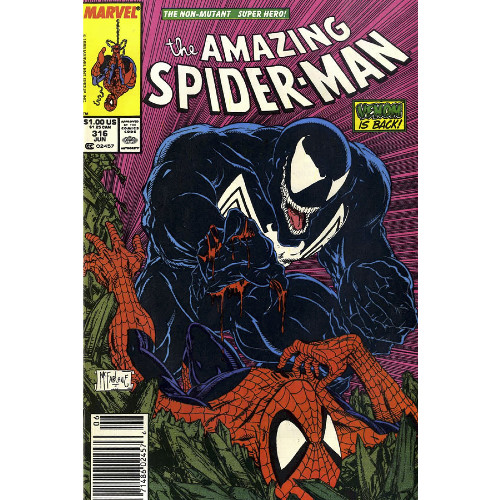
"Crawling Back" is going where it has rarely crawled before…the 80s!
So far, this series has "flashed back" to decades not covered in my "Spider-view" reviews, namely, the 60s and 70s. These posts have been an opportunity to explore the earliest eras of Spider-Man history, covering his origin, his first fight with the Sinister Six, the first appearance of the Green Goblin, and even Gwen Stacy's death. I've largely focused on stories penned by Stan Lee, though Gerry Conway has slipped by to tell a tale or two. My only other foray into the 80s for this series was an examination of Contest of Champions, Marvel's first-ever limited series.
Back when I started blogging, I initially intended to hit some "big" Spider-Man narratives during the 80s and quickly move into the 90s. Nearly five years in, I've barely scratched the surface of the 1990s. Through "Spider-view," I reviewed some of those intended "larger" narratives, such as the "Alien Costume Saga," Spidey's infamous tussle with the Juggernaut, and "The Death of Jean DeWolff," but then I got swept up in doing sequential reviews of Amazing Spider-Man arcs, beginning with the "Cosmic Spider-Man" saga kicking off in ASM #326.
Venom's first appearance in ASM #300 was always one of those "larger" stories I intended on reviewing. But once I fell into "story by story" mode, the next Venom narrative I ended up reviewing was his third appearance, beginning in ASM #332. I even begged the reader's forgiveness for skipping over Venom's second appearance, which we are now finally discussing today.
The black-suited Spidey-stalker has popped up multiple times recently in my reviews, primarily as Marvel geared up in the early 90s to give the villain-turning-antihero his very first limited series (of many). In preparation for Venom's first solo series, I wanted to tackle this narrative, particularly because of an important connection between the two tales. Thus, as I have done periodically with another "Crawling Back" series-within-a-series, I am providing an "interlude" post between Venom's most recent appearance and the beginning of his "Lethal Protector" era. So step back with me just a few years, back before Venom developed his twisted philosophy of innocence, before he was stranded on a beach, before his "son" tried to kill him, before readers even found out Eddie Brock had a wife. Forget all that for now. I'm sure our Web-Head wishes he could. Sadly, he has to face his famous foe in a story I'm referring to as…
"The Return of Venom"
Writer: David Michelinie
Penciler: Todd McFarlane
Inker: Todd McFarlane
Colorist: Bob Sharen
Letterer: Rick Parker
Issues: Amazing Spider-Man #315-317
Issue Publication Dates: May 1989-July 1989
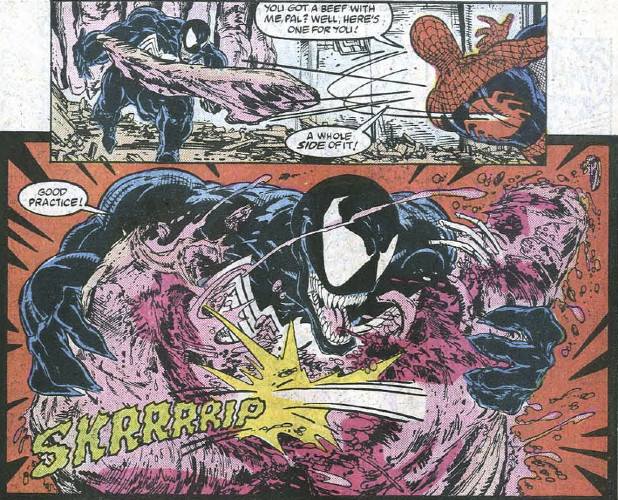
Let's talk character evolution.
If you went and looked at my posts tagged "Venom," you'd witness quite the leap between ASM #300, where the character debuted, and ASM #332, marking that third appearance I noted. And I'm not referring to a leap in time or between issues, though that certainly happens. I'm talking about a leap in design.
Let's actually take another slight step backward, to ASM #299, where readers first saw Venom, a brief glimpse at the tail end of the issue (as the character plays more significantly into ASM #300, I defer to that as his first appearance). In that "cameo appearance" (as Wikipedia calls it), Venom terrifies the living daylights out of Mary Jane, who initially believes the dark figure is her husband in his black-and-white Spidey costume (which Peter was actively wearing at the time). Stepping into the light, Venom is bulky, his teeth and jaw somewhat exaggerated in a Joker-esque grin. But his teeth are still human, he has no tongue lolling about, and there isn't any spittle flying from his lips. Even his clawed hands aren't terribly impressive, looking more intimidating than practical.
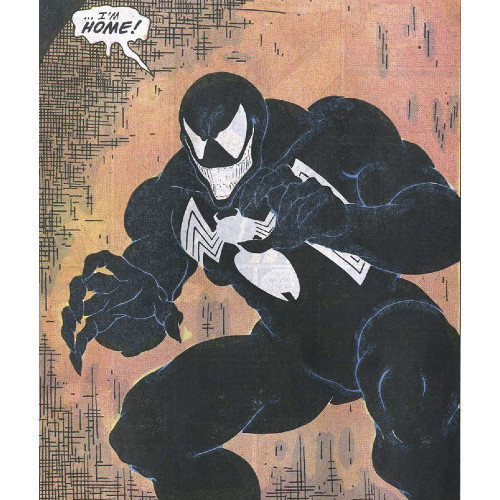
If you jump to ASM #332, you'll note the wild differences already. Venom retains his bulk, but Erik Larsen depicts the jaw as massive, the claws sharp, the tongue protruding like an angry reptile's. Venom is more monstrous in design, more inhuman. The slightly hyperbolic human grin has been replaced with a set of razor-sharp teeth. It's a considerable jump, but I noted it isn't completely without precedent. In these issues we're reviewing today, McFarlane is already toying with the design, turning Venom into something less human. The teeth are more razored, the jaw is slightly unhinged. If Larsen went full alligator mode with Venom's head, then McFarlane at least provides him a blueprint by adding more of a reptilian appearance to the character. His name is "Venom," after all.
Aside from the updated design, Venom is given a little more leeway with his character in these issues. He's solidly situated in supervillain territory, not yet espousing his twisted philosophy on innocence…at least, not in terms of the general public. Venom himself still feels betrayed by Spider-Man–Eddie Brock for believing Spidey cost him his reporting job, the symbiote for feeling scorned by his once-host. But this Venom isn't afraid to dirty his hands–he murders one prison guard, nearly kills another, and threatens to murder a homeless man. He trounces the Black Cat and seemingly attempts to kill Aunt May, even while calling her "innocent."
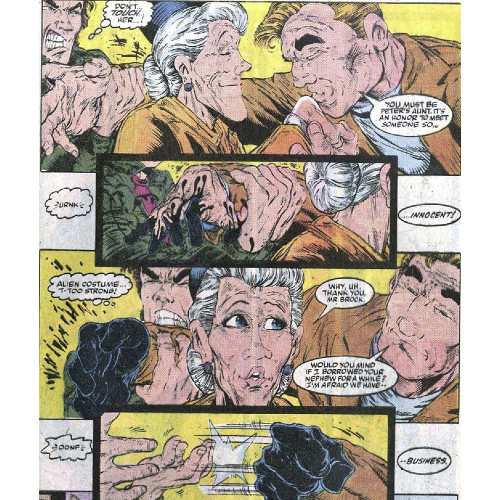
Michelinie appears to be experimenting with the character in these issues. Yes, the hatred Venom feels towards Spidey is palpable and constant, but what supervillain doesn't hold some kind of grudge against the Web-Head? Michelinie is trying to make something different with this character, reinforcing the dual threat of Eddie knowing Peter's secret identity and Venom's ability to evade Peter's spider-sense. He learns where Peter and MJ are staying, breaks into their old apartment, beats Spidey's former girlfriend, and makes it clear he could murder Aunt May at any time. He's vicious in these issues, laying the groundwork for just why Peter becomes so terrified of him in later installments and heightening MJ's already existing fear of the man.
Venom is the natural conclusion of Peter's fears–someone learning who he is and where his loved ones live. The threat has come from other sources before–I'm reminded of one Spidey/Green Goblin skirmish where the hero prevented Norman Osborn's alter ego from attacking May, and let's not forget the Goblin is responsible for killing at least one major member of the hero's supporting cast–but Eddie is right in Peter's face about it. He's direct, manipulating the safety of Peter's family to get what he wants. He doesn't hide behind a mask or require his coincidental amnesia to fade in order to attack our hero. Eddie and the symbiote are the same creature, and so both are equally threatening to Peter.

The ending is also worth noting because it's the first of several times where Peter walks away believing he's defeated his latest arch-enemy for good. As I have mentioned elsewhere, Venom's increasing popularity always prevented him from fading into obscurity, particularly when he began starring in his own series (and that's "series," plural). And I suppose it can be a little deflating when a hero defeats a villain only to remark that the threat is ended…for now! But Michelinie returns to this notion of Venom's ultimate defeat time and again–it happens here, when Spidey stranded Venom on an island, and even when Spidey made an infamous "deal" with the supervillain.
These issues also afford us some conflict in the life of Peter Parker, Michelinie weaving in ongoing subplots to try and make sure the time Peter spends in and out of the mask is fairly balanced. We're back in the "Aunt May boarding house" era, when Nathan Lubensky was still alive…and addicted to gambling. MJ's cousin Kristy pops up, primarily to flirt with and annoy Peter, and we feel some tension involving Peter and MJ's living situation (thanks to her obsessive stalker Jonathan Caesar, who I've previously referenced in passing). These subplots would be easier to discuss in their entirety, instead of the piecemeal fashion in which I've referred to them, but maybe some of these smaller narratives will get their own posts in the future. For now, they make up a few pages in these three issues, reminding us Peter has more complexities going on than just being followed by a crazed ex-reporter who wants to rip one final story out of our hero.
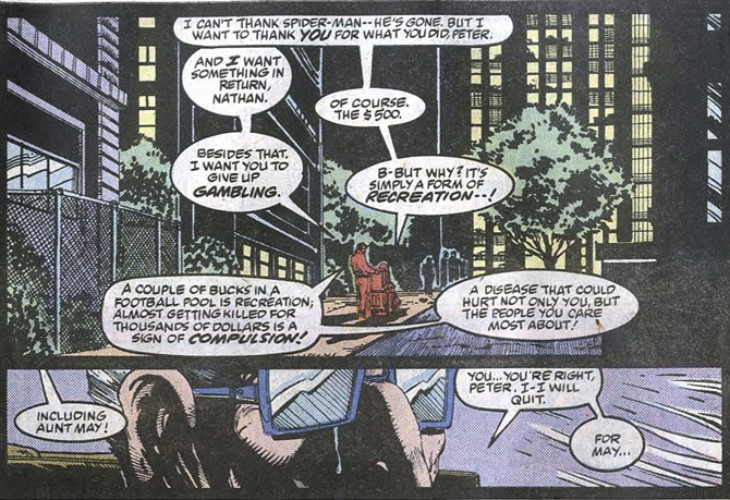
Think of these issues as "transitory." We're in the middle of Michelinie developing his most popular contribution to the Spider-Man mythos–and, no, I don't mean Kristy Watson–adding on some details and expanding Venom's scope. We get a greater sense of his craftiness, and a slight look at what a more animalistic Venom could become. I've already covered subsequent narratives which flesh out the character's design and personality, grounding him in his bizarre obsession with innocence and how exactly he defines who is innocent and who isn't. Spider-Man clearly isn't, I can tell you that. He's #1 on Venom's hit list, and these issues just reinforce that hatred that several other narratives will explore. It's over, Peter thinks after defeating his foe at the end of this arc, and I wish someone was around to him it isn't. It's far from over…and this particular conflict may never end.